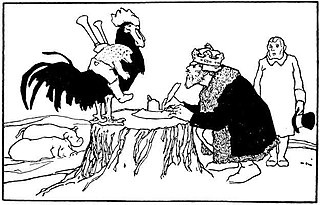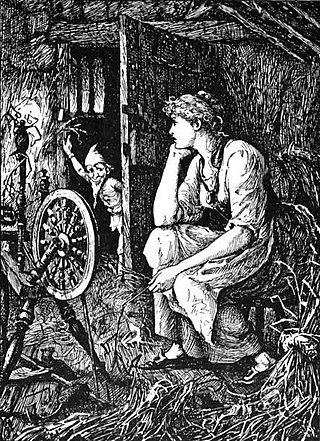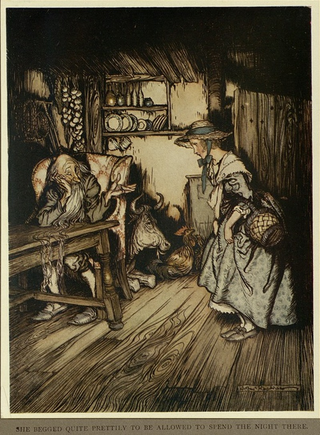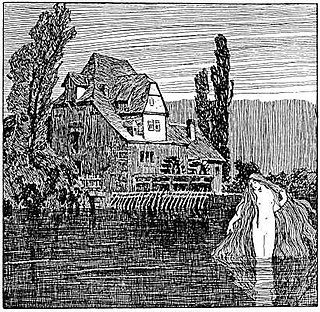
"Hans My Hedgehog" is a German fairy tale collected by the Brothers Grimm. The tale was translated as Jack My Hedgehog by Andrew Lang and published in The Green Fairy Book. It is of Aarne-Thompson type 441.

The Langs' Fairy Books are a series of 25 collections of true and fictional stories for children published between 1889 and 1913 by Andrew Lang and his wife, Leonora Blanche Alleyne. The best known books of the series are the 12 collections of fairy tales also known as Andrew Lang's "Coloured" Fairy Books or Andrew Lang's Fairy Books of Many Colors. In all, the volumes feature 798 stories, besides the 153 poems in The Blue Poetry Book.
The Brown Bear of Norway is an Irish fairy tale collected by Patrick Kennedy which appeared in his Legendary Fictions of the Irish Celts (1866). It was later included by Andrew Lang in his anthology The Lilac Fairy Book (1910), though Lang misattributed his source as West Highland Tales.

"Bearskin" is a fairy tale collected by the Brothers Grimm. A variant from Sicily, "Don Giovanni de la Fortuna", was collected by Laura Gonzenbach in Sicilianische Märchen and included by Andrew Lang in The Pink Fairy Book. Italo Calvino included another Italian version, "The Devil's Breeches" from Bologna, in his Italian Folktales.

Shita-kiri Suzume, translated literally into "Tongue-Cut Sparrow", is a traditional Japanese fable telling of a kind old man, his avaricious wife and an injured sparrow. The story explores the effects of greed, friendship and jealousy on the characters.

The Two Brothers is a German fairy tale collected by the Brothers Grimm, tale number 60. It is Aarne-Thompson type 303, "The Blood Brothers", with an initial episode of type 567, "The Magic Bird Heart". A similar story, of Sicilian origin, was also collected by author and folklorist Andrew Lang in The Pink Fairy Book.
"The Story of Three Wonderful Beggars" is a Serbian fairy tale. It is also known as Vasilii the Unlucky its Russian form, collected by Alexander Afanasyev in Narodnye russkie skazki.

"The Hut in the Forest" is a German fairy tale collected by the Brothers Grimm. Andrew Lang included it in The Pink Fairy Book (1897). It is Aarne-Thompson type 431.
"The Three Little Birds" is a German fairy tale collected by the Brothers Grimm, tale number 96. The story is originally written in Low German. It is Aarne-Thompson type 707, the dancing water, the singing apple, and the speaking bird. The story resembles Ancilotto, King of Provino, by Giovanni Francesco Straparola, and The Sisters Envious of Their Cadette, the story of the 756th night of the Arabian Nights.
The One-Handed Girl is a Swahili fairy tale, collected by Edward Steere in Swahili Tales. Andrew Lang included it in The Lilac Fairy Book.
Why the Sea Is Salt is a Norwegian fairy tale collected by Peter Christen Asbjørnsen and Jørgen Moe in their Norske Folkeeventyr. Andrew Lang included it in The Blue Fairy Book (1889).
The Tale of the Hoodie is a Scottish fairy tale, collected by John Francis Campbell in his Popular Tales of the West Highlands. Andrew Lang included it, as The Hoodie-Crow, in The Lilac Fairy Book.
The False Prince and the True is a Portuguese fairy tale. Andrew Lang included it in The Lilac Fairy Book.
The Cottager and his Cat is an Icelandic fairy tale collected in Islandische Marchen. Andrew Lang included it in The Crimson Fairy Book.
The Tale of the Shifty Lad, the Widow's Son is a Scottish fairy tale collected by John Francis Campbell in Popular Tales of the West Highlands. Andrew Lang included it, as The Shifty Lad in The Lilac Fairy Book. The tale was reprinted in Scottish Fairy and Folk Tales, by George Brisbane Scott Douglas.
The Three Treasures of the Giants is a Slavonic fairy tale collected by Louis Léger in Contes Populaires Slaves. Andrew Lang included it in The Orange Fairy Book. Ruth Manning-Sanders included it as "King Johnny" in A Book of Giants.

"The Nixie of the Mill-Pond" is a German fairy tale that tells the story of a man captured by a nix and his wife's efforts to save him. The Brothers Grimm collected the tale in their Grimm's Fairy Tales (1857) as tale number 181. A note in the volume indicated that it was current in Upper Lusatia when the story was collected. Andrew Lang included a version in The Yellow Fairy Book, citing his source Hermann Kletke and titling it The Nixy.

"The Grave Mound" is a German fairy tale collected by the Brothers Grimm, KHM 195. It is Aarne-Thompson type 779, Divine Rewards and Punishments.

The Golden Starfruit Tree is a Vietnamese folktale. It tells the story of a poor farmer who is paid handsomely by a magical bird after letting it feeds on his starfruit tree and his rich older brother who perishes from his own greediness.
The Story of The Farmer's Three Daughters is an Icelandic fairy tale collected by author Jón Árnason in his 1864 compilation of Icelandic tales and legends. It is related to the theme of the calumniated wife and classified in the Aarne-Thompson-Uther Index as type ATU 707, "The Three Golden Children".








